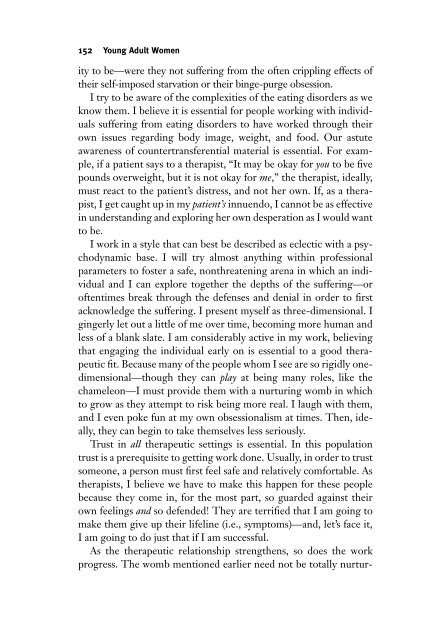Eating Disorders - fieldi
Eating Disorders - fieldi
Eating Disorders - fieldi
You also want an ePaper? Increase the reach of your titles
YUMPU automatically turns print PDFs into web optimized ePapers that Google loves.
152 Young Adult Women<br />
ity to be—were they not suffering from the often crippling effects of<br />
their self-imposed starvation or their binge-purge obsession.<br />
I try to be aware of the complexities of the eating disorders as we<br />
know them. I believe it is essential for people working with individuals<br />
suffering from eating disorders to have worked through their<br />
own issues regarding body image, weight, and food. Our astute<br />
awareness of countertransferential material is essential. For example,<br />
if a patient says to a therapist, “It may be okay for you to be five<br />
pounds overweight, but it is not okay for me,” the therapist, ideally,<br />
must react to the patient’s distress, and not her own. If, as a therapist,<br />
I get caught up in my patient’s innuendo, I cannot be as effective<br />
in understanding and exploring her own desperation as I would want<br />
to be.<br />
I work in a style that can best be described as eclectic with a psychodynamic<br />
base. I will try almost anything within professional<br />
parameters to foster a safe, nonthreatening arena in which an individual<br />
and I can explore together the depths of the suffering—or<br />
oftentimes break through the defenses and denial in order to first<br />
acknowledge the suffering. I present myself as three-dimensional. I<br />
gingerly let out a little of me over time, becoming more human and<br />
less of a blank slate. I am considerably active in my work, believing<br />
that engaging the individual early on is essential to a good therapeutic<br />
fit. Because many of the people whom I see are so rigidly onedimensional—though<br />
they can play at being many roles, like the<br />
chameleon—I must provide them with a nurturing womb in which<br />
to grow as they attempt to risk being more real. I laugh with them,<br />
and I even poke fun at my own obsessionalism at times. Then, ideally,<br />
they can begin to take themselves less seriously.<br />
Trust in all therapeutic settings is essential. In this population<br />
trust is a prerequisite to getting work done. Usually, in order to trust<br />
someone, a person must first feel safe and relatively comfortable. As<br />
therapists, I believe we have to make this happen for these people<br />
because they come in, for the most part, so guarded against their<br />
own feelings and so defended! They are terrified that I am going to<br />
make them give up their lifeline (i.e., symptoms)—and, let’s face it,<br />
I am going to do just that if I am successful.<br />
As the therapeutic relationship strengthens, so does the work<br />
progress. The womb mentioned earlier need not be totally nurtur-









